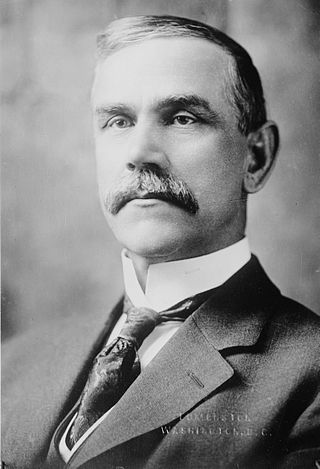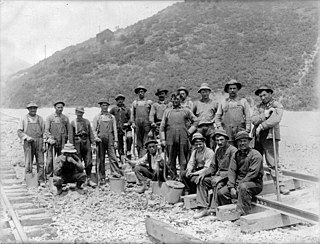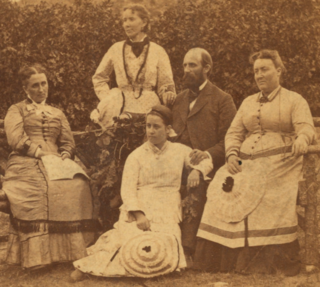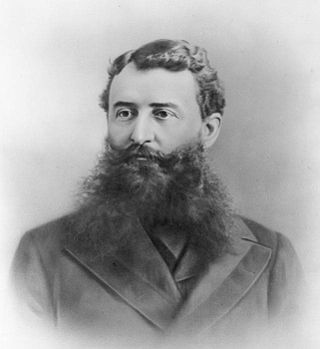
Reed Smoot was an American politician, businessman, and apostle of the Church of Jesus Christ of Latter-day Saints. A Republican who was first elected to the U.S. Senate by the Utah State Legislature in 1902, he served from 1903 to 1933. Smoot is primarily remembered as the co-sponsor of the 1930 Smoot–Hawley Tariff Act, which increased almost 900 American import duties. Criticized at the time as having "intensified nationalism all over the world" by Thomas Lamont of J.P. Morgan & Co., Smoot–Hawley is widely regarded as one of the catalysts for the worsening Great Depression.

The Territory of Utah was an organized incorporated territory of the United States that existed from September 9, 1850, until January 4, 1896, when the final extent of the territory was admitted to the Union as the State of Utah, the 45th state. At its creation, the Territory of Utah included all of the present-day State of Utah, most of the present-day state of Nevada save for Southern Nevada, much of present-day western Colorado, and the extreme southwest corner of present-day Wyoming.

Since Utah became a U.S. state in 1896, it has sent congressional delegations to the United States Senate and United States House of Representatives. Each state elects two senators to serve for six years. Before the Seventeenth Amendment in 1913, senators were elected by the Utah State Legislature. Members of the House of Representatives are elected to two-year terms, one from each of Utah's four congressional districts. Before becoming a state, the Territory of Utah elected a non-voting delegate at-large to Congress from 1850 to 1896.

George Quayle Cannon was an early member of the Quorum of the Twelve Apostles of the Church of Jesus Christ of Latter-day Saints, and served in the First Presidency under four successive presidents of the church: Brigham Young, John Taylor, Wilford Woodruff, and Lorenzo Snow. He was the church's chief political strategist, and was dubbed "the Mormon premier" and "the Mormon Richelieu" by the press. He was also a five-time Utah territorial delegate to the U.S. Congress.

The Liberal Party was a political party established in the latter half of the 1800s in Utah Territory before the national Democrats and Republicans established themselves in Utah in the early 1890s.

The 1890 Manifesto is a statement which officially advised against any future plural marriage in the Church of Jesus Christ of Latter-day Saints. Issued by Church President Wilford Woodruff in September 1890, the Manifesto was a response to mounting anti-polygamy pressure from the United States Congress, which by 1890 had disincorporated the church, escheated its assets to the U.S. federal government, and imprisoned many prominent polygamist Mormons. Upon its issuance, the LDS Church in conference accepted Woodruff's Manifesto as "authoritative and binding."

Reynolds v. United States, 98 U.S. 145 (1878), was a Supreme Court of the United States case that held that religious duty was not a defense to a criminal indictment. Reynolds was the first Supreme Court opinion to address the First Amendment's protection of religious liberties, impartial juries and the Confrontation Clauses of the Sixth Amendment.

Eli Houston Murray was Governor of Utah Territory between 1880 and 1886. The city of Murray, Utah was named for him.

Frank Jenne Cannon was the first United States Senator from Utah, who served from 1896 to 1899.

The Utah Republican Party is the affiliate of the Republican Party in the U.S. state of Utah. It is currently the dominant party in the state, and has been for almost all of its history. It currently holds Utah's entire congressional delegation, all statewide executive offices, and supermajorities in both state legislative chambers.

Angus Munn Cannon was an early Latter Day Saint leader and Mormon pioneer.

Possibly as early as the 1830s, followers of the Latter Day Saint movement, were practicing the doctrine of polygamy or "plural marriage". After the death of church founder Joseph Smith, the doctrine was officially announced in Utah Territory in 1852 by Mormon leader Brigham Young. The practice was attributed posthumously to Smith and it began among Mormons at large, principally in Utah where the Church of Jesus Christ of Latter-day Saints had relocated after the Illinois Mormon War.
Both houses of the United States Congress have refused to seat new members based on Article I, Section 5 of the United States Constitution which states that:
"Each House shall be the judge of the elections, returns and qualifications of its own members, and a majority of each shall constitute a quorum to do business; but a smaller number may adjourn from day to day, and may be authorized to compel the attendance of absent members, in such manner, and under such penalties as each House may provide."

Women's suffrage was first granted in Utah in 1870, in the pre-federal period, decades before statehood. Among all U.S. states, only Wyoming granted suffrage to women earlier than Utah. Because Utah held two elections before Wyoming, Utah women were the first women to cast ballots in the United States after the start of the suffrage movement. However, in 1887 the Edmunds–Tucker Act was passed by Congress in an effort to curtail Mormon influence in the territorial government, disallowing the enfranchisement of the women residents within Utah Territory. Women regained the vote upon Utah statehood in 1896, when lawmakers included the right in the state constitution.

Early in its history, the Church of Jesus Christ of Latter-day Saints had a series of negative encounters with the federal government of the United States. This led to decades of mistrust, armed conflict, and the eventual disincorporation of the church by an act of the United States Congress. The relationship between the church and the government eventually improved, and in recent times LDS Church members have served in leadership positions in Congress and held other important political offices. The LDS Church becomes involved in political matters if it perceives that there is a moral issue at stake and wields considerable influence on a national level with over a dozen members of Congress having membership in the church in the early 2000s, and about 80% of Utah state lawmakers identifying as LDS.

The 1904 United States presidential election in Utah was held on November 8, 1904, throughout all forty-five contemporary states as part of the 1904 United States presidential election. State voters chose three representatives, or electors to the Electoral College, who voted for president and vice president.

The 1900 United States presidential election in Utah took place on November 6, 1900, as part of the 1900 United States presidential election held in each of the forty-five contemporary states. State voters chose three representatives, or electors to the Electoral College, who voted for president and vice president.

The 1896 United States presidential election in Utah was held on November 3, 1896 as part of the 1896 United States presidential election. Voters chose three representatives, or electors to the Electoral College, who voted for president and vice president. This was the first time Utah participated in a presidential election, having been admitted as the 45th state on January 4 of that year.
The twin relics of barbarism refer to the popular nineteenth-century phrase that linked the practices of slavery and polygamy in the United States. Attention to these twin relics increased following the 1856 Republican National Convention as the party acknowledged both practices in their party platform. Within the party's planks, they called on Congress to firmly denounce the "twin relics of barbarism –– Polygamy and Slavery." During this period, slavery was widely practiced among southern states, and polygamy was becoming prevalent among members of the Church of Jesus Christ of Latter-day Saints. The growth of these practices stoked fear and uncertainty in the nation at large as the two practices were seen as "incongruous with the pure and the free, the just and safe principles inaugurated by the [American] Revolution." As a result of the widespread opposition to each, they were increasingly coupled together in national print media throughout the country.
The Utah Constitutional Convention was held from March 4, 1895 to May 8, 1895. The 1895 convention was the Utah Territory's seventh and final attempt to be admitted to the United States as a state. The Constitution of Utah was accepted by Congress and President Grover Cleveland, leading to Utah's admittance into the union as the 45th state on January 4, 1896.
















